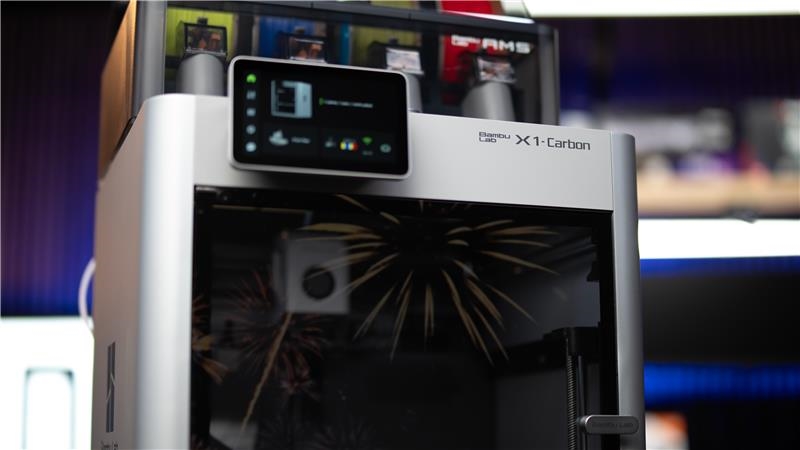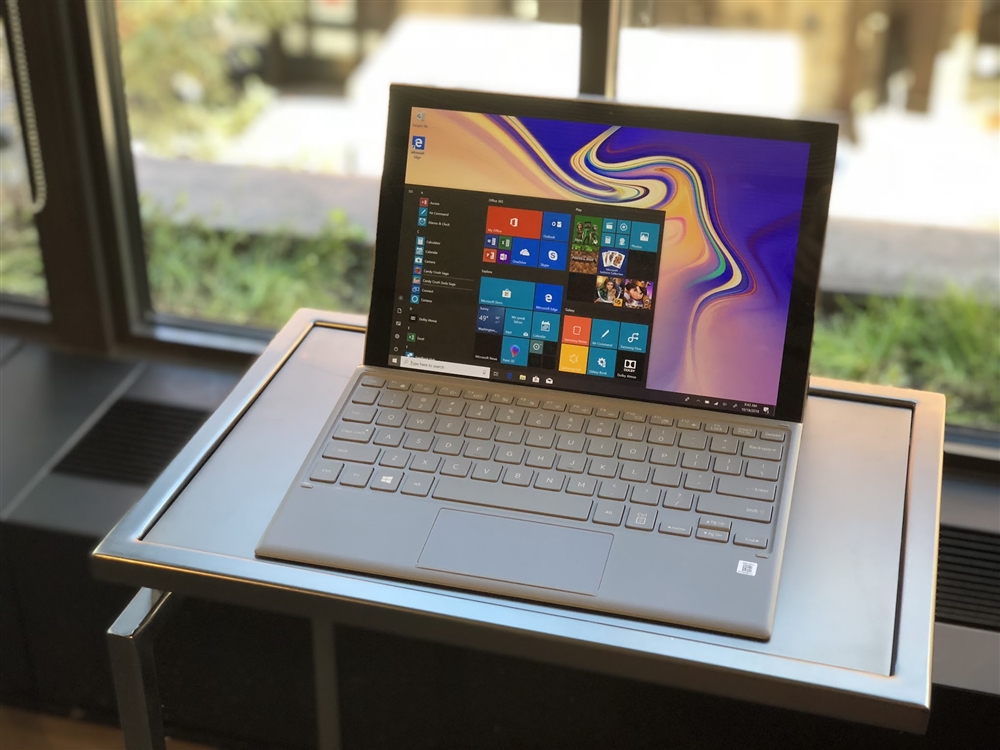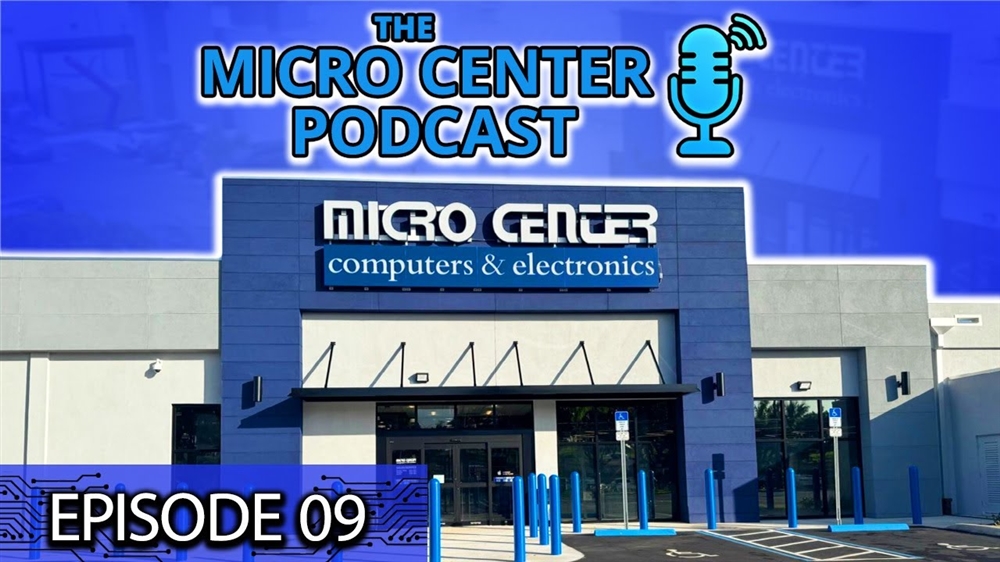Can You Use a TV as a Computer Monitor?
Let's get to the core question that you came here for: Can you use a TV as a computer monitor, and how do you do it if so?How-To
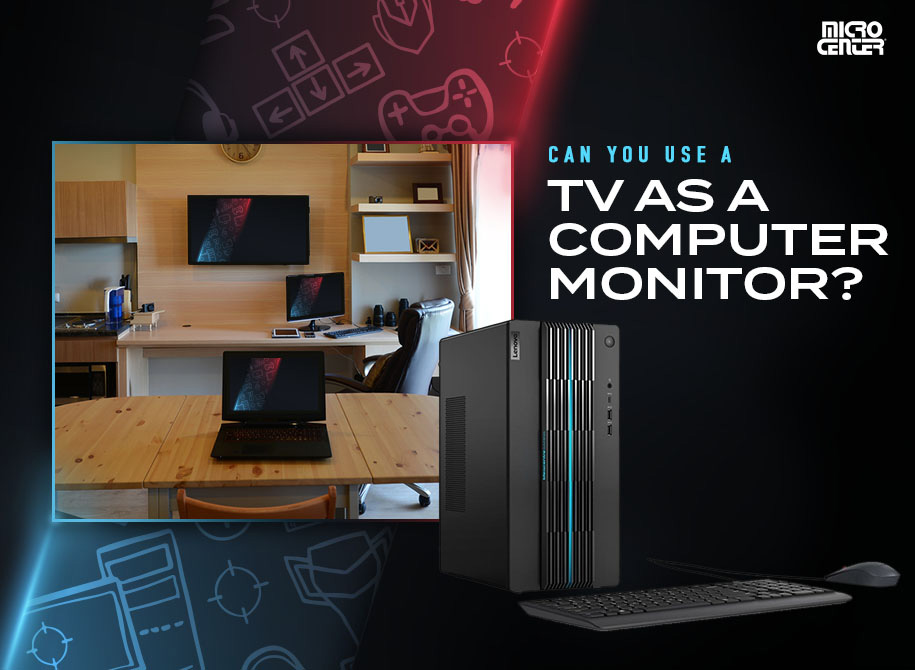
At the simplest level, a TV and a computer monitor do basically the same thing: receive a digital input and then turn it into a visual output using a pixelated screen. So it's not hard to see why it's increasingly popular to use a TV as a monitor. After all, when TVs are bigger and more affordable than ever, why even worry about a monitor?
There can be some advantages to leaving monitors behind, but there are also plenty of reasons why TVs and monitors are still their own things, with their own purposes. If you're wondering what those are, you're in the right place! Up ahead, we'll dive into the differences, pros and cons, and what you can expect when using your TV as a computer monitor.
First, though, let's get to the core question that you came here for: Can you use a TV as a computer monitor, and how do you do it if so?
Can You Use a TV as a Computer Monitor?
The answer, in most cases, is yes — nearly all modern TVs can be used as computer monitors. In fact, it's usually an easy process:
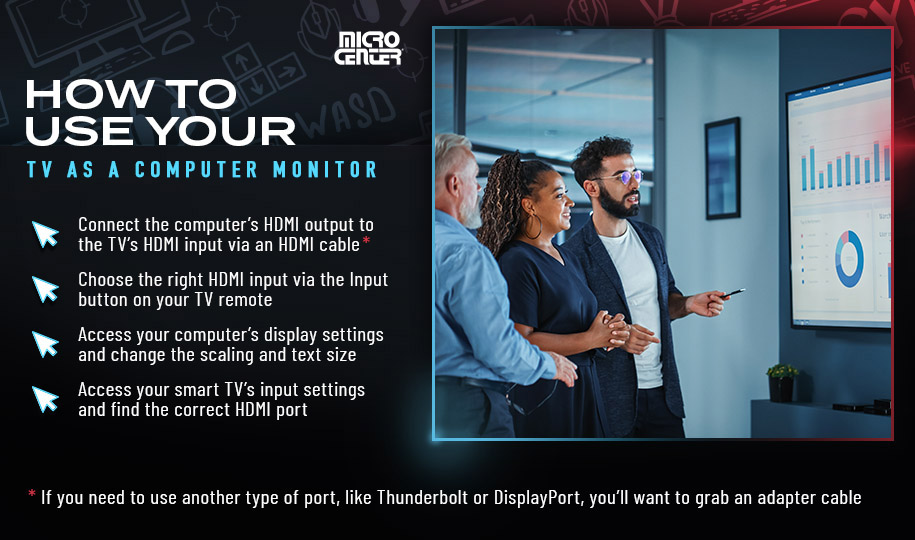
- If your computer has an HDMI port free, then you'll simply connect the computer's HDMI output to the TV's HDMI input via an HDMI cable. If you need to use another type of port, like Thunderbolt or DisplayPort, you'll want to grab an adapter cable.
- Once you've made the connection, choose the right HDMI input via the Input button on your TV remote.Your output should automatically appear in the highest resolution your TV and PC can support.
- Sometimes, the image displayed on your TV might appear too large or too small, in which case you'll need to access your computer's display settings and change the scaling and text size until you've found settings that are comfortable for you. If part of your screen looks “cut off,” you might be suffering from overscan, which you can usually fix via the control software for your GPU.
- Access your smart TV's input settings and find the HDMI port where your computer is plugged in. On most TVs, you'll be able to choose from a list of device types, so select “PC.” This should automatically configure your TV to turn off extra post-processing effects and turn on chroma subsampling.
Congratulations, you're now using your TV as a monitor! It really is that simple — but what's not necessarily simple is figuring out whether a TV is actually right for the job. For that, we're going to need to cover a little more information.
Pros and Cons of TVs as Computer Monitors
So, you almost certainly can use your TV for a computer monitor — but should you? Is a TV a better option for most people than a standard PC monitor? That all depends on what you need from your display.
PROS
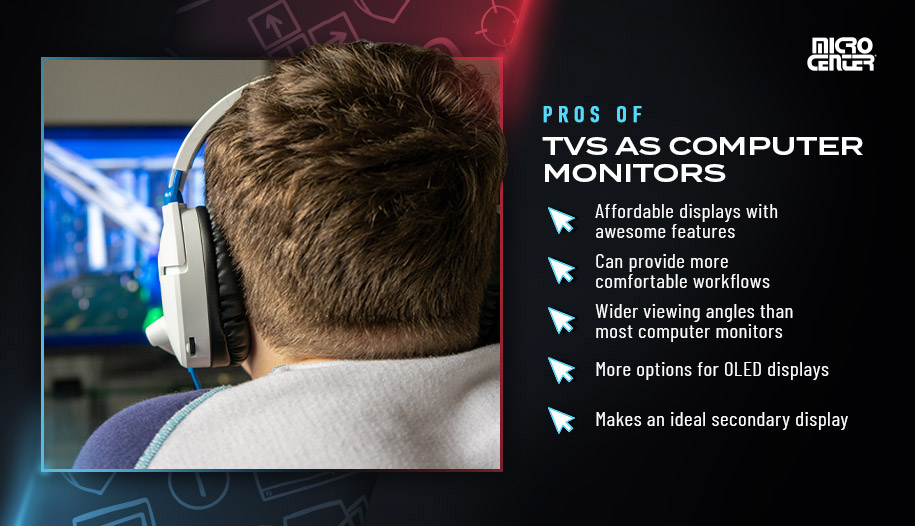
Affordable displays with awesome features.
We're living in something of a golden age for affordable and feature-rich TVs. Practically every modern HDTV offers 4K UHD resolution and HDR support, so even budget models can offer excellent performance. What's more, you'll often spot eye-popping deals on some very large and well-equipped TV models.
So, in terms of bang for the buck, it's hard to beat what TVs offer: Large displays with premium features and tons of options. Monitors can offer some of this, but they almost always come at a higher price point than TVs with comparable screen sizes and features. And if you've got a serious gaming PC that's waiting to have its graphical powers unleashed, a TV offers a cost-effective way to enter the world of 4K PC gaming in style.
More screen real estate can provide more comfortable workflows (and more immersive gaming).
Do you work with CAD files, DAW files, tons of spreadsheets, or video editing projects? The huge display sizes that TVs offer can make a real difference in these workflows. You get all the screen real estate of dual monitors, but in a single gigantic display that's perfect for any kind of spread-out or linear workflow.
As you might expect, 4K TVs are also phenomenal for PC gaming. The size of a TV display instantly levels up your immersion, and if you've got a 4K-capable PC, watch out — you might never go back to a monitor. Again, a 40-plus-inch 4K gaming monitor can come with a large price tag, while 4K TVs of the same size can offer a comparably cost-effective way to get your game on the big screen.
Wider viewing angles than most computer monitors.
Most TVs are designed with a wide viewing angle, meaning the image will maintain uniformity and color fidelity no matter which angle you're viewing it from. That's because they're typically designed to allow a group of two or more people to watch together. On the other hand, computer monitors have significantly more narrow viewing angles since they're most often designed for a single user.
Thus, if you need a computer display with a wider than normal viewing angle, a TV can be a smart option. It might be a display you're planning to use while moving around the room, one that multiple people are going to use to collaborate, or even one that you're going to use as your all-in-one media center to watch Netflix with friends after work.
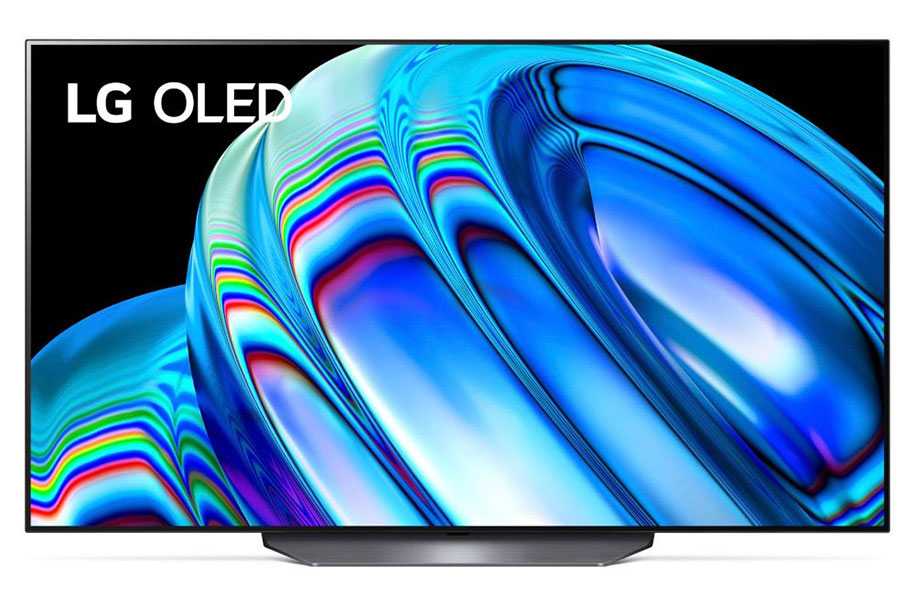
More options for OLED displays.
Organic LED (OLED) TVs occupy the top tier in today's world of displays, with unmatched contrast depth that produces coveted “true blacks” for night scenes. However, if you've decided it's time to move up to an OLED as a gaming and media monitor, you might be shocked to discover that (as of yet) they're relatively uncommon.
OLED TVs, on the other hand, are widely available, and steadily becoming more affordable. Although more OLED monitors are beginning to hit the market, getting a smaller OLED TV can be the fastest and easiest way to get the unmatched contrast of OLED for your gaming and media. (Note that we only recommend using an OLED TV as a secondary media and gaming monitor since — as we'll discuss more in a second — using it as an everyday PC monitor can put you at risk of burn-in.)
Makes an ideal secondary display.
Do you want a secondary display to use for specific purposes (like gaming or movies) alongside your primary computer monitor? A TV could be perfect for your needs. A standard monitor with a TV on a side table is a convenient setup that allows you to switch back and forth whenever you want using an HDMI switch.
TVs sometimes aren't ideal for everyday desktop PC functions, but they're great for enjoying your favorite media. Using a TV as a secondary display is a great “best of both worlds” solution: use your standard computer monitor for email, graphic design, or other areas that monitors excel at, and then switch over to your TV for game time or movie night.
CONS
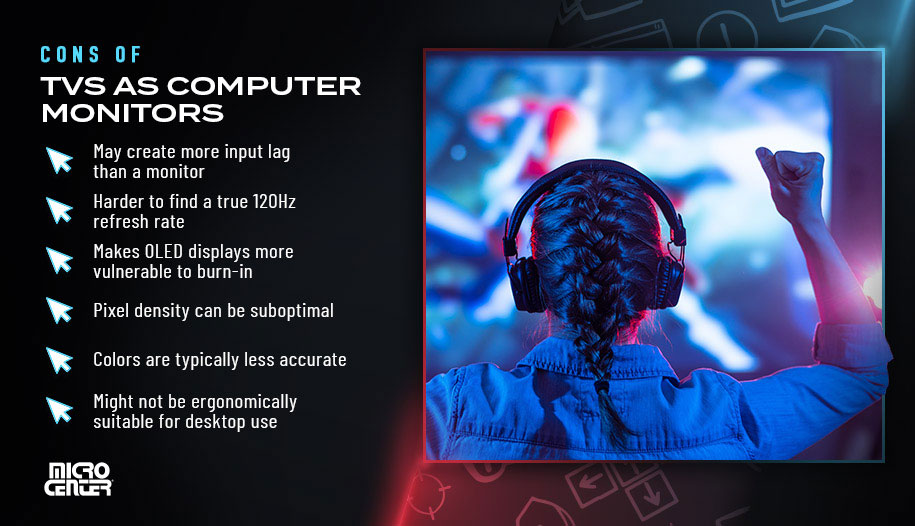
May create more input lag than a monitor.
TVs use all kinds of post-processing technologies between their input and output to create visual effects like smoothness and vividness. That's fine for movies and TV, but the post-processing can introduce serious lag between inputs and outputs. This is especially a problem for gamers, but it can be annoying for any computer user, especially on a TV with high latency.
Fortunately, many TVs now have an easy way around this via the Game Mode or PC Mode setting. This mode greatly reduces the post-processing applied to the image and prioritizes fast input times instead. Some TVs' Game Mode settings offer lower latency than others. Look for models with a Game Mode latency under 25 ms for the best performance.
Harder to find a true 120Hz refresh rate.
Some PC users — gamers in particular — look for displays with a high refresh rate. Basically, this means the display can load a large number of frames per second, producing the smooth and stutter-free graphics that gamers need. 120Hz refresh rates are the gold standard, but they're not as widely available on TVs.
That's right — although 120Hz TVs are more widely available than they used to be, monitors still hold an advantage in this area. Computer monitors for sale today often offer native 120Hz refresh rates, with high-refresh monitors available in a whole range of shapes and sizes. True native 120Hz refresh rate TVs are still fairly uncommon, although many TVs use interpolation technologies to approximate a 120Hz refresh rate.
Makes OLED displays more vulnerable to burn-in.
OLED displays have traditionally had one big caveat: burn-in, the phenomenon that makes some OLED panels retain images after displaying them for too long. Today's OLED TVs have made big strides in preventing burn-in, but the problem can be a bit trickier to solve when using a TV as a monitor.
That's because computer monitors have to display static images often — think of the icons in your taskbar, your desktop wallpaper, or the interface of your web browser or word processor. Thus, as we mentioned earlier, we don't recommend using OLEDs as primary monitors, although they make excellent secondary displays for media and gaming.
Pixel density can be suboptimal for close-up viewing
Pixel density basically means how closely spaced the pixels of a digital display are (measured in pixels per inch, or ppi). At a viewing distance of five feet or more, the difference is almost impossible to notice, but up close, an image with lower pixel density may appear somewhat blurry (especially text).
Monitors designed for close-up viewing have higher pixel densities that produce crystal-clear images up close. Because they're larger and designed to be viewed from farther away, TVs are generally built with lower ppi than monitors. Since this is mostly a function of screen size and resolution, it's best to simply sit farther back (which you'll probably want to do anyway due to the larger screen).
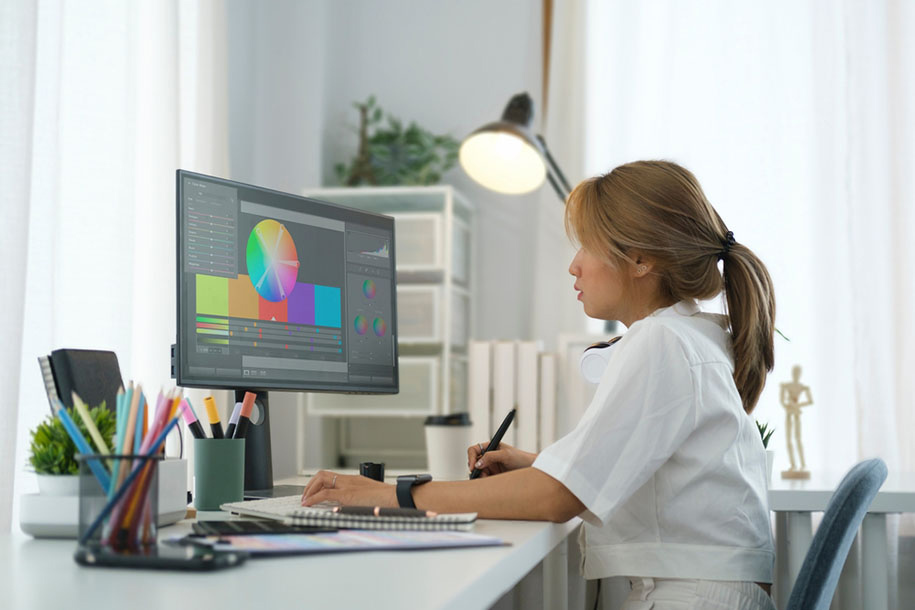
Colors are typically less accurate on a TV than a monitor.
As a rule, TVs are less color accurate than monitors, especially out of the box. Depending on the picture mode, TVs apply various filters and processing effects to make colors more vibrant, but that doesn't mean these colors are necessarily more accurate compared to the values of color standards like sRGB or DCI-P3. The TV's color palette will still look great, but it may not appear exactly the same as it would on other displays.
Most computer monitors for sale today are designed to prioritize color accuracy and consistency, especially since users often purchase them for professional applications like graphic design or photo retouching. Some monitors are more accurate than others, but by and large, a monitor is a better choice over a TV if color accuracy is important. Some TV users do calibrate their displays for more accurate colors, but it can be a lot of work and still may not get you the results of a monitor.
Might not be ergonomically suitable for desktop use.
Ergonomics can be one of the most significant pain points for anyone who wants to use a TV as a monitor. Some TVs aren't designed to be as desk-friendly as monitors and may be awkward to place on a desk. Except for a relatively small number of curved TVs, you also won't find the ergonomic, eye-friendly bend of a curved monitor there.
The sheer size difference of switching from a monitor to a TV can create some challenges. With any TV over 40-plus inches, you'll probably have to sit at least a little bit farther back than a conventionally sized monitor to avoid eye and neck strain, and the recommended distance increases further for bigger screens. Getting the height of the display right can also require some experimentation on a larger screen since you'll still want your eyes to be at the right level for everyday monitor use.
Micro Center has a full selection of TVs that make great monitors — not to mention TVs that make great TVs, and monitors that make great monitors. See every option in our TV collection and monitor collection to find the display that will make everything crystal clear.
Comment on This Post
See More Blog Categories
Recent Posts
The End is Coming for Windows 10: What You (Still) Need to Know
With the official end-of-support date for the world's most popular PC operating system fast approaching, here's how to keep your PC secure and decide if it's finally time for an upgrade.
Continue Reading About The End is Coming for Windows 10: What You (Still) Need to Know


